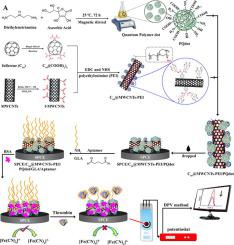Bioelectrochemistry ( IF 5 ) Pub Date : 2020-11-18 , DOI: 10.1016/j.bioelechem.2020.107701 Hamid Reza Jamei 1 , Behzad Rezaei 1 , Ali Asghar Ensafi 1

|
In this study, an ultra-sensitive and selective Thrombin biosensor with aptamer-recognition surface is introduced based on carbon nanocomposite. To prepare the this biosensor, screen-printed carbon electrodes (SPCE) were modified with a nanocomposite made from fullerene (C60), multi-walled carbon nanotubes (MWCNTs), polyethylenimine (PEI) and polymer quantum dots (PQdot). The unique characteristics of each component of the C60/MWCNTs-PEI/PQdot nanocomposite allow for synergy between nanoparticles while polymer quantum dots resulted in characteristics such as high stability, high surface to volume ratio, high electrical conductivity, high biocompatibility, and high mechanical and chemical stability. The large number of amine groups in C60/MWCNTs-PEI/PQdot nanocomposite created more sites for better covalent immobilization of amino-linked aptamer (APT) which improved the sensitivity and stability of the aptasensor. Differential Pulse Voltammetry (DPV) method with probe solution was used as the measurment method. Binding of thrombin protein to aptamers immobilized on the transducer resulted in reduced electron transfer at the electrode/electrolyte interface which reduces the peak current (IP) in DPV. The calibration curve was drawn using the changes in the peak current (ΔIP),. The proposed aptasensor has a very low detection limit of 6 fmol L−1, and a large linear range of 50 fmol L−1 to 20 nmol L−1. Furthermore, the proposed C60/MWCNTs-PEI/PQdot/APT aptasensor has good reproducibility, great selectivity, low response time and a good stability during its storage. Finally, the application of the proposed aptasensor for measuring thrombin on human blood serum samples was investigated. This aptasensor can be useful in bioengineering and biomedicine applications as well as for clinical studies.
中文翻译:

具有基于聚合物量子点和C 60 / MWCNTs-聚乙烯亚胺纳米复合物的适体识别表面的超灵敏选择性电化学生物传感器,用于凝血酶蛋白分析
在这项研究中,基于碳纳米复合材料,介绍了一种具有适体识别表面的超灵敏选择性凝血酶生物传感器。为了制备这种生物传感器,用富勒烯(C 60),多壁碳纳米管(MWCNT),聚乙烯亚胺(PEI)和聚合物量子点(PQdot)制成的纳米复合材料修饰丝网印刷的碳电极(SPCE )。C 60 / MWCNTs-PEI / PQdot纳米复合材料各组分的独特特性可实现纳米颗粒之间的协同作用,而聚合物量子点则具有诸如高稳定性,高表面积与体积比,高电导率,高生物相容性和高机械性能的特性和化学稳定性。C 60中有大量胺基/ MWCNTs-PEI / PQdot纳米复合材料创建了更多位点,以更好地共价固定氨基连接的适体(APT),从而提高了适体传感器的灵敏度和稳定性。测量方法采用探针溶液差分脉冲伏安法(DPV)。凝血酶蛋白与固定在换能器上的适体的结合导致在电极/电解质界面的电子转移减少,从而降低了DPV中的峰值电流(I P)。校准曲线使用在峰值电流(ΔI的变化绘制P),. 提出的适体传感器具有非常低的6 fmol L -1的检测极限,以及50 fmol L -1至20 nmol L -1的大线性范围。此外,建议的C 60/ MWCNTs-PEI / PQdot / APT适体传感器在存储过程中具有良好的可重复性,选择性好,响应时间短和稳定性好的特点。最后,研究了所提出的适体传感器在人血清样品中测定凝血酶的应用。该适体传感器可用于生物工程和生物医学应用以及临床研究。



























 京公网安备 11010802027423号
京公网安备 11010802027423号